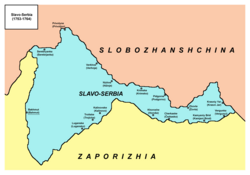Slavo-Serbia
| Slavo-Serbia Славеносрбија Славяносербия Слов’яносе́рбія |
|||||
| territory of Russian Empire | |||||
|
|||||
| Capital | Bakhmut (Bahmut) | ||||
| History | |||||
| • | Established | 1753 | |||
| • | Abolished | 1764 | |||
Slavo-Serbia (Ukrainian: Слов’яносе́рбія; Russian: Славяносербия (Slavyanoserbiya); Serbian: Славеносрбија or Slavenosrbija; archaic Serbian name: Славено-Сербія) was a territory of Imperial Russia between 1753 and 1764. It was located by the right bank of the Donets River between the Bakhmut (Бахмут) and Luhan (Лугань) rivers. This area today constitutes the territories of present-day Luhansk Oblast and Donetsk Oblast of Ukraine. The administrative centre of Slavo-Serbia was Bakhmut (Bahmut).
By the decree of the Senate of May 29, 1753, the free lands of this area were offered for settlement to Serbs, Vlachs (Romanians), Bulgarians, Greeks and other Balkan peoples of Orthodox Christian denomination to ensure frontier protection and development of this part of the steppes. Slavo-Serbia was directly governed by Russia's Governing Senate and College of War. The settlers eventually formed the Bakhmut hussar regiment in 1764. Also in 1764, Slavo-Serbia was transformed into the Donets uyezd of Yekaterinoslav Governorate (now in Dnipropetrovs'ka oblast', Ukraine). Commandants of Slavo-Serbia were Colonels Rajko Preradović and Jovan Šević. These Serbian colonels led their soldiers in various Russian military campaigns; in peacetime they kept the borderlands, along with the Cossacks, free from incursions by other states.
...
Wikipedia

